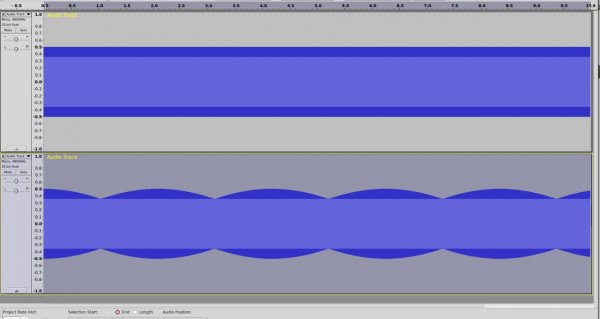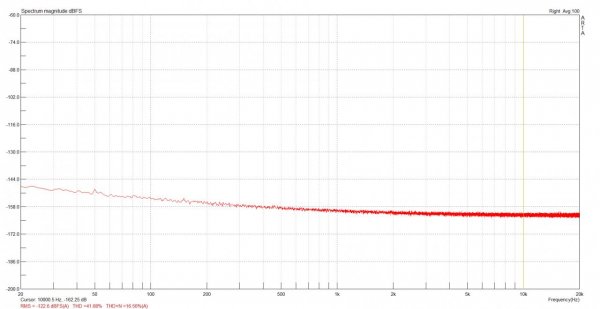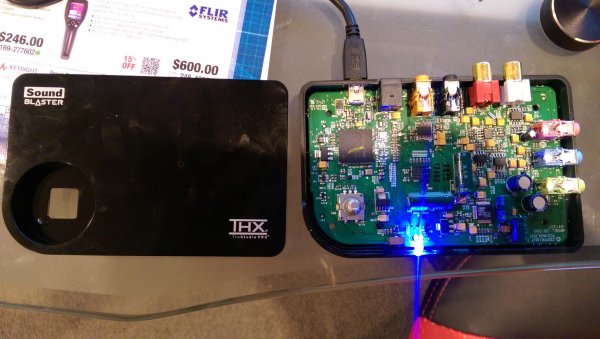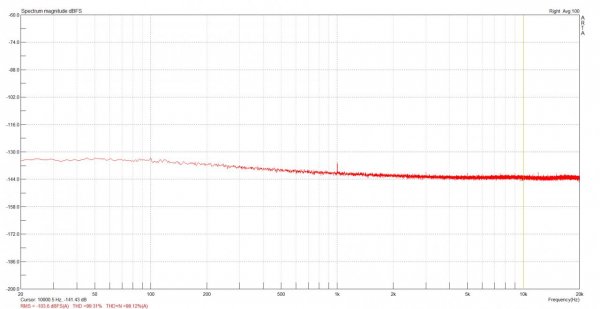Member Fiddle Faddle and I have been communicating on ways to test the Entreq. He was kind enough to send me this detailed post highlighting the measures he took to try to get reliable capture. I thought I share it here as it has good information. Repeatable measurements using a PC which capturing low-level detail is important and I enjoyed reading the techniques he used.
Please share your thoughts here. BUT DO NOT DISCUSS THE Entreq in the specific. Thank you .
.
---
My Entreq tests
Hi Amir,
Yes, my Entreq tests were both fraught with "hidden" difficulties. I had always imagined that even an analogue noise floor (which effectively was what I was measuring here) would be nice and consistent with a fully warmed up machine, however I found that this was only the case when a number of test parameters were extremely tightly controlled.
For example, even with the Windows 7 power profiles, small changes in CPU demands would reveal tiny, but observable changes in the noise floor. I thought I had gotten around that issue years ago by having a special "audio boot mode" (which I still use). This mode simply makes a number of (reversible) registry changes then reboots the machine. Once rebooted there are only 20 essential processes running, there is a custom power profile and a few other changes. But I found that in my Entreq testing, it was actually better to have the CPU utilisation parameters (in the power profile) set very conservatively. After much experimentation (with the sole objective being to obtain a perfectly consistent noise floor), I found that setting the minimum and maximum CPU power states to 25% seemed to achieve this. It seemed the higher I went, the higher the noise level but just as importantly, the less consistent it was - even with just 20 essential processes running. I should note that even at my "default" audio settings, the noise was still consistent with the playback card specifications - roughly 114 dB S/N ratio at 96 KHz and around 121 dB dynamic range - but just not as good or consistent as it was when throttling back on the CPU power parameters.
With that in mind, I actually did some other testing whereby I purposely started up an additional (normally unwanted) process just to see what it did to the noise floor. Sure enough, adding a CPU-hungry process did make a tiny change to the noise floor as well. At least this did arguably validate my efforts when setting up the workstation to limit the number of processes to absolutely essential ones only.
Then another interesting thing I noticed: Not only did the audio API I used make a difference to the noise floor, but so did the playback software I used! So WASAPI had a different noise floor to ASIO which was different to kernel streaming...and Foobar (for example) had a different noise floor to XXhighEnd (with XXHighEnd looking better, more consistent and less "jaggy"). In the end, I settled for ASIO playback only for a simple reason - on the playback card, it is the only API of the four available to me in Windows 7 that completely bypasses everything including the volume control. In other words, that mode was a truly "bit perfect" one - all the others - including WASAPI - would permit volume adjustments and even also DSP (such as EQ, etc).
Anyway, so in the end I did find parameters that kept the noise floor perfectly consistent for my tests, but had I not done this testing first, I would never have been able to produce a repeatable and reliable (in the circumstances and with the modest equipment at hand) result.
As for the Entreq box itself, there does seem to be an observable "rubber band" effect when connecting and disconnecting, but I did not have the time to thoroughly examine this. Nor did I consider my testing regime or equipment sufficiently good to even produce any meaningful data relating to it in any case.
In the first tests (with that "antenna" cable), the connect / disconnect results were actually ostensibly instant. Well instant in terms of I noticed the noise floor changes within the time frame needed to go to the back of the workstation, remove the cable then go back to the front of it again (so maybe 45 seconds at most). Then again, obviously there was so much noise in those first tests to begin with, if anything more subtle was happening, there was likely no way to really know.
In the second set of tests things were quite different. I actually began the second series of tests with the Entreq having already been connected for 24 hours. I was happy with the consistency of the noise floor, then ran 3 separate tests over a 15 minute period, comparing each result and making sure the results were the same (they will never be 100% identical test after test unless you are only measuring within the digital domain, but I wanted to make sure they all matched as closely as possible - and they did).
So then I disconnected the Entreq box as per usual and was "horrified" to see no change! I thought to myself - this box does nothing! (yet it had obviously made a significant difference with the terrible cable). Just as I was trying to figure out why nothing was happening, I see the noise floor begin to increase right before my eyes. I think within about 15 minutes the peaks had increased so as to be fairly consistent with my final results, but I allowed half an hour in the final test.
Not happy with this result (nothing apparently happening upon an instant disconnect), I then went to the trouble of repeating the whole test - but this time I obviously did not have the box reconnected for long - again I was "cycling" with 15 minutes on / 15 minutes off. Luckily my results were then consistent - the noise floor dropped then went up according to whether the box was connected or not. Obviously when you have an experience like that, you start questioning whether other factors are causing the noise floor fluctuations and you've just experienced a lucky (or unlucky) coincidence. But I think given how tightly I attempted to control all the other parameters (time of day - well, actually night), turning everything electrical off in the house, ensuring workstation had been warmed up for at least 12 hours prior to any testing, etc, then the results were more than likely caused by the Entreq. And given that I actually did three "cycling" tests - and each time the noise floor changed accordingly, then I think my results are reasonably robust (but again, only within the confines of the overall test - meaning a lack of an audio analyser and the lack of high quality source and recording equipment to begin with, let alone my lack of experience with serious measurement of any kind). In the end though, I actually recorded all of those noise floors then edited them in Sound Forge Pro as so as to amplify them by 100 dB or so - it was then clear the Entreq was doing "something". It was basically producing an "Entreq-specific-sounding" noise floor that was audibly different sounding to the one without once amplified so as to actually be audible.
As for how long it really does take to fully "do it's thing" (or conversely, not), I don't really know other than being fairly certain it was not necessarily instantaneous in my case - except when tested with that terrible cable. What I do feel, however, is that were I to perform any sort of rigorous Entreq testing, I'd probably be trying to measure the noise floor immediately after a disconnect, then again after 30 minutes, then 2 hours, then again after a day and then finally - if possible - after a couple of days (see more detail at the end of this PM regarding this). Again, it does not seem to matter if the equipment is actually being used during this time. Merely that the Entreq box is connected and that connection is not interrupted in any way.
And again, I did not spend much time investigating the effect of a disconnect over time. Never more than 15 - 30 minutes. And I never did any formal listening tests either like this (but there was the subjective anecdotal experience I had where I wondered why the system was not sounding its usual self one evening, only to find the cat had dislodged the Entreq cable - the connectors are their weak point. I do not like them at all). But that could have happened 24 hours prior or half an hour prior. I don't know. And it was a subjective opinion only anyway.
So here is one way I might do it, giving due consideration to the "rubber band" effect, existing users subjective feedback, Entreq guidelines as well as logistical (including time spent) concerns:
- Test rig has been warmed up for 12 hours (Entreq has never been connected before).
- Measure noise floor (and possibly a second test with a single sine wave and then a third test with two sine waves to test IM).
- Connect Entreq
- Measure immediately
- Wait 30 minutes
- Re-measure
- Wait another 90 minutes
- Re-measure
- Wait 24 hours
- Re-measure
- Disconnect Entreq
- Measure immediately
- Wait 30 minutes
- Re-measure
- Wait another 90 minutes
- Re-measure
- Wait 24 hours
- Re-measure
Maybe if with the connection tests you did one additional, final test after 48 hours, no one would have any basis to complain (this is on the assumption you could measure a change to begin with in a lesser time period). Though to be honest, if you do see any changes, I suspect nothing much will happen after 2 hours and that if it does improve over two days, that improvement will be extremely small and thus extremely hard to reliably and meaningfully measure in an analogue domain.
Anyway, I hope some of the above comments are useful to you. I don't know what boxes and cables you will test but personally speaking, if I were to measure this stuff properly, I wouldn't be wanting to teat anything less than a Silver Tellus at the minimum. By the way, the cable used makes quite an audible difference (sorry, my subjective experience only). What I don't know though, is how the cable itself influences the result versus the box itself (for example, is the noise floor just the same and it "distributes" the noise differently - in other words, each cable is a "noise shaper" and the box determines actual overall performance).
Regards
Please share your thoughts here. BUT DO NOT DISCUSS THE Entreq in the specific. Thank you
---
My Entreq tests
Hi Amir,
Yes, my Entreq tests were both fraught with "hidden" difficulties. I had always imagined that even an analogue noise floor (which effectively was what I was measuring here) would be nice and consistent with a fully warmed up machine, however I found that this was only the case when a number of test parameters were extremely tightly controlled.
For example, even with the Windows 7 power profiles, small changes in CPU demands would reveal tiny, but observable changes in the noise floor. I thought I had gotten around that issue years ago by having a special "audio boot mode" (which I still use). This mode simply makes a number of (reversible) registry changes then reboots the machine. Once rebooted there are only 20 essential processes running, there is a custom power profile and a few other changes. But I found that in my Entreq testing, it was actually better to have the CPU utilisation parameters (in the power profile) set very conservatively. After much experimentation (with the sole objective being to obtain a perfectly consistent noise floor), I found that setting the minimum and maximum CPU power states to 25% seemed to achieve this. It seemed the higher I went, the higher the noise level but just as importantly, the less consistent it was - even with just 20 essential processes running. I should note that even at my "default" audio settings, the noise was still consistent with the playback card specifications - roughly 114 dB S/N ratio at 96 KHz and around 121 dB dynamic range - but just not as good or consistent as it was when throttling back on the CPU power parameters.
With that in mind, I actually did some other testing whereby I purposely started up an additional (normally unwanted) process just to see what it did to the noise floor. Sure enough, adding a CPU-hungry process did make a tiny change to the noise floor as well. At least this did arguably validate my efforts when setting up the workstation to limit the number of processes to absolutely essential ones only.
Then another interesting thing I noticed: Not only did the audio API I used make a difference to the noise floor, but so did the playback software I used! So WASAPI had a different noise floor to ASIO which was different to kernel streaming...and Foobar (for example) had a different noise floor to XXhighEnd (with XXHighEnd looking better, more consistent and less "jaggy"). In the end, I settled for ASIO playback only for a simple reason - on the playback card, it is the only API of the four available to me in Windows 7 that completely bypasses everything including the volume control. In other words, that mode was a truly "bit perfect" one - all the others - including WASAPI - would permit volume adjustments and even also DSP (such as EQ, etc).
Anyway, so in the end I did find parameters that kept the noise floor perfectly consistent for my tests, but had I not done this testing first, I would never have been able to produce a repeatable and reliable (in the circumstances and with the modest equipment at hand) result.
As for the Entreq box itself, there does seem to be an observable "rubber band" effect when connecting and disconnecting, but I did not have the time to thoroughly examine this. Nor did I consider my testing regime or equipment sufficiently good to even produce any meaningful data relating to it in any case.
In the first tests (with that "antenna" cable), the connect / disconnect results were actually ostensibly instant. Well instant in terms of I noticed the noise floor changes within the time frame needed to go to the back of the workstation, remove the cable then go back to the front of it again (so maybe 45 seconds at most). Then again, obviously there was so much noise in those first tests to begin with, if anything more subtle was happening, there was likely no way to really know.
In the second set of tests things were quite different. I actually began the second series of tests with the Entreq having already been connected for 24 hours. I was happy with the consistency of the noise floor, then ran 3 separate tests over a 15 minute period, comparing each result and making sure the results were the same (they will never be 100% identical test after test unless you are only measuring within the digital domain, but I wanted to make sure they all matched as closely as possible - and they did).
So then I disconnected the Entreq box as per usual and was "horrified" to see no change! I thought to myself - this box does nothing! (yet it had obviously made a significant difference with the terrible cable). Just as I was trying to figure out why nothing was happening, I see the noise floor begin to increase right before my eyes. I think within about 15 minutes the peaks had increased so as to be fairly consistent with my final results, but I allowed half an hour in the final test.
Not happy with this result (nothing apparently happening upon an instant disconnect), I then went to the trouble of repeating the whole test - but this time I obviously did not have the box reconnected for long - again I was "cycling" with 15 minutes on / 15 minutes off. Luckily my results were then consistent - the noise floor dropped then went up according to whether the box was connected or not. Obviously when you have an experience like that, you start questioning whether other factors are causing the noise floor fluctuations and you've just experienced a lucky (or unlucky) coincidence. But I think given how tightly I attempted to control all the other parameters (time of day - well, actually night), turning everything electrical off in the house, ensuring workstation had been warmed up for at least 12 hours prior to any testing, etc, then the results were more than likely caused by the Entreq. And given that I actually did three "cycling" tests - and each time the noise floor changed accordingly, then I think my results are reasonably robust (but again, only within the confines of the overall test - meaning a lack of an audio analyser and the lack of high quality source and recording equipment to begin with, let alone my lack of experience with serious measurement of any kind). In the end though, I actually recorded all of those noise floors then edited them in Sound Forge Pro as so as to amplify them by 100 dB or so - it was then clear the Entreq was doing "something". It was basically producing an "Entreq-specific-sounding" noise floor that was audibly different sounding to the one without once amplified so as to actually be audible.
As for how long it really does take to fully "do it's thing" (or conversely, not), I don't really know other than being fairly certain it was not necessarily instantaneous in my case - except when tested with that terrible cable. What I do feel, however, is that were I to perform any sort of rigorous Entreq testing, I'd probably be trying to measure the noise floor immediately after a disconnect, then again after 30 minutes, then 2 hours, then again after a day and then finally - if possible - after a couple of days (see more detail at the end of this PM regarding this). Again, it does not seem to matter if the equipment is actually being used during this time. Merely that the Entreq box is connected and that connection is not interrupted in any way.
And again, I did not spend much time investigating the effect of a disconnect over time. Never more than 15 - 30 minutes. And I never did any formal listening tests either like this (but there was the subjective anecdotal experience I had where I wondered why the system was not sounding its usual self one evening, only to find the cat had dislodged the Entreq cable - the connectors are their weak point. I do not like them at all). But that could have happened 24 hours prior or half an hour prior. I don't know. And it was a subjective opinion only anyway.
So here is one way I might do it, giving due consideration to the "rubber band" effect, existing users subjective feedback, Entreq guidelines as well as logistical (including time spent) concerns:
- Test rig has been warmed up for 12 hours (Entreq has never been connected before).
- Measure noise floor (and possibly a second test with a single sine wave and then a third test with two sine waves to test IM).
- Connect Entreq
- Measure immediately
- Wait 30 minutes
- Re-measure
- Wait another 90 minutes
- Re-measure
- Wait 24 hours
- Re-measure
- Disconnect Entreq
- Measure immediately
- Wait 30 minutes
- Re-measure
- Wait another 90 minutes
- Re-measure
- Wait 24 hours
- Re-measure
Maybe if with the connection tests you did one additional, final test after 48 hours, no one would have any basis to complain (this is on the assumption you could measure a change to begin with in a lesser time period). Though to be honest, if you do see any changes, I suspect nothing much will happen after 2 hours and that if it does improve over two days, that improvement will be extremely small and thus extremely hard to reliably and meaningfully measure in an analogue domain.
Anyway, I hope some of the above comments are useful to you. I don't know what boxes and cables you will test but personally speaking, if I were to measure this stuff properly, I wouldn't be wanting to teat anything less than a Silver Tellus at the minimum. By the way, the cable used makes quite an audible difference (sorry, my subjective experience only). What I don't know though, is how the cable itself influences the result versus the box itself (for example, is the noise floor just the same and it "distributes" the noise differently - in other words, each cable is a "noise shaper" and the box determines actual overall performance).
Regards





